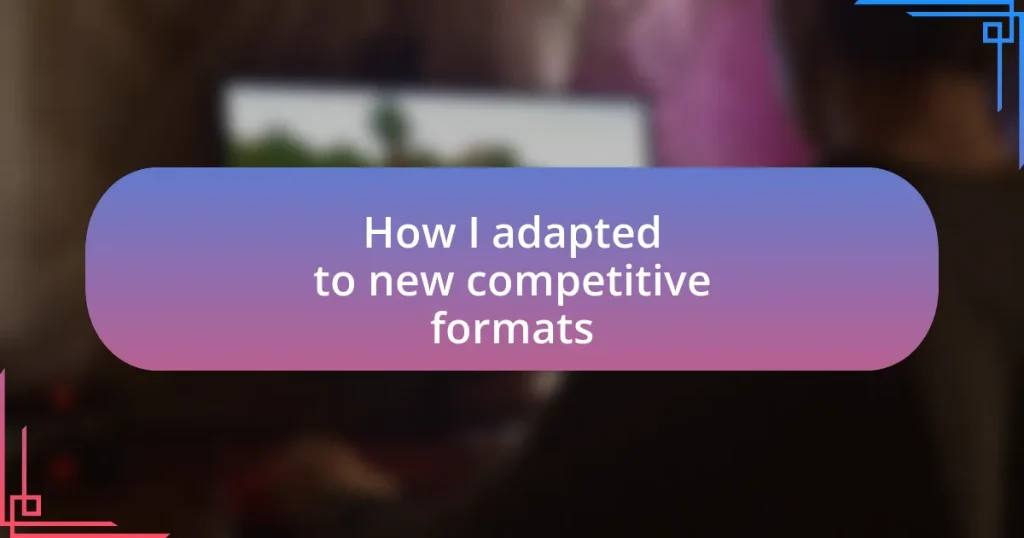Key takeaways:
- Understanding competitive formats involves adapting to specific rules and community expectations, which can reveal hidden strengths.
- Key trends include real-time engagement, collaboration, technology use, mental resilience, and hybrid formats prioritizing sustainability.
- Setting clear, adaptable goals is essential for progress, especially in the face of unexpected challenges and personal growth opportunities.
- Leveraging feedback from peers and performance analysis fosters emotional resilience and enhances overall adaptability in competitive environments.
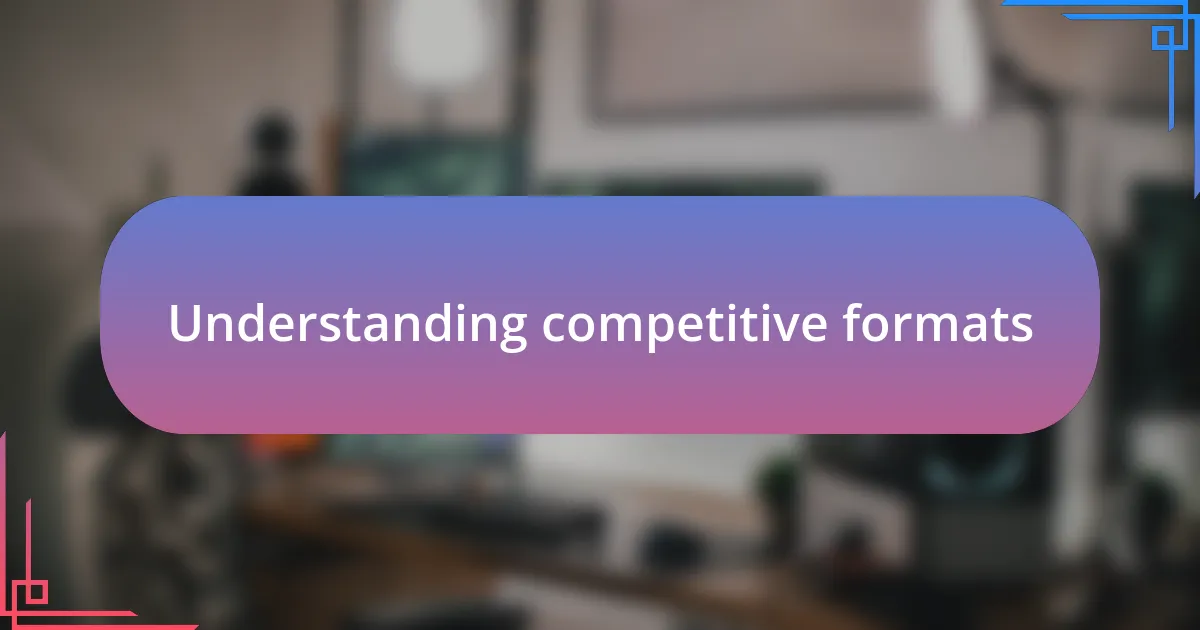
Understanding competitive formats
Competitive formats vary widely across different industries and disciplines, each bringing unique challenges and strategies. I remember when I first encountered a new format that required rapid decision-making under pressure. How could I adapt my previous experiences to excel in this fast-paced environment?
As I delved deeper into understanding these formats, I discovered that they often hinge on specific rules and community expectations. The thrill of figuring out what makes each format tick can be exhilarating. It’s like piecing together a puzzle; the more I engaged with it, the clearer the picture became.
Embracing these competitive formats usually involves a learning curve, sometimes a steep one. I’ve found that a willingness to learn and adjust is crucial. Have you ever felt overwhelmed by a new challenge, only to find that it pushed you to grow in unexpected ways? For me, adapting to the nuances of these formats often revealed strengths I didn’t know I had, making the journey worthwhile.
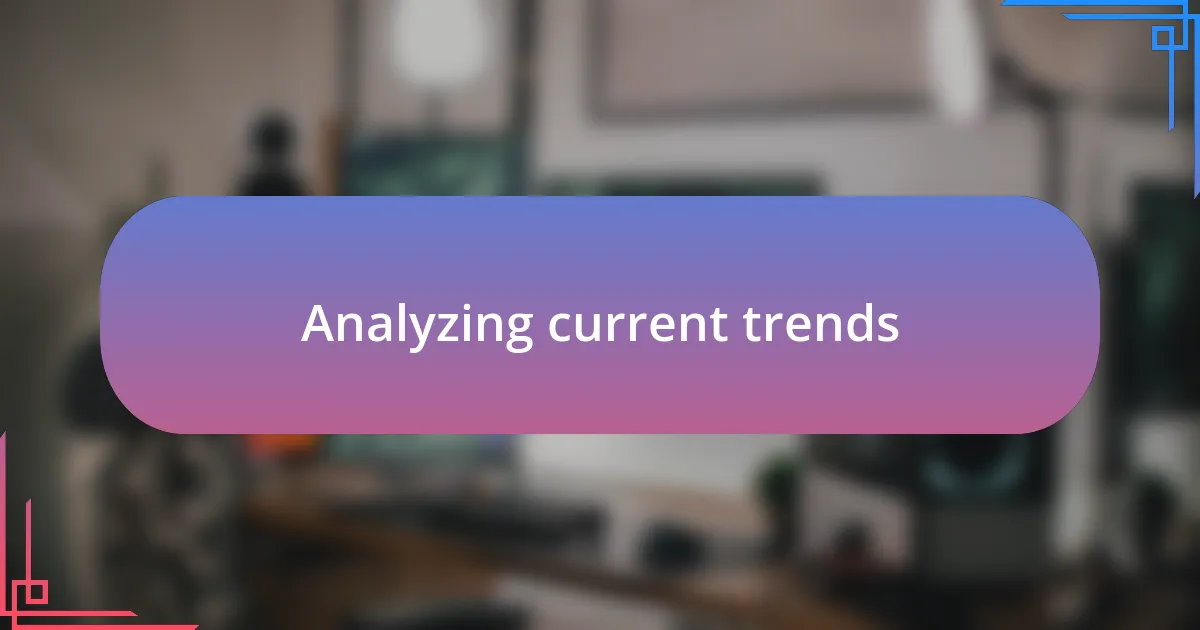
Analyzing current trends
Analyzing current trends in competitive formats reveals a fascinating landscape. I’ve observed that many sectors are moving towards real-time engagement and feedback loops, where participants can adjust strategies almost instantaneously. This trend not only heightens the excitement but also requires a more agile mindset. It reminds me of a recent tournament where the ability to pivot your game plan based on live data drastically shifted the outcome.
Key trends include:
- Increased emphasis on collaboration and teamwork, even in traditionally individual sports.
- The use of technology, such as apps and analytics, to gather real-time performance data.
- Growing popularity of formats that prioritize sustainability and inclusivity.
- An ever-present need for mental resilience, as the pace of competition accelerates.
- A shift towards hybrid formats that blend online and offline engagement.
As I navigated these trends, I found that embracing technology made a significant impact on my preparation. At one point, I reluctantly downloaded a performance-tracking app. To my surprise, it opened my eyes to areas I could improve, transforming my approach completely. The exhilarating moment when I finally conquered a personal best in the adjusted format was nothing short of euphoric. It made me realize that adapting to current trends isn’t just about keeping up; it’s about harnessing these insights to elevate my game.
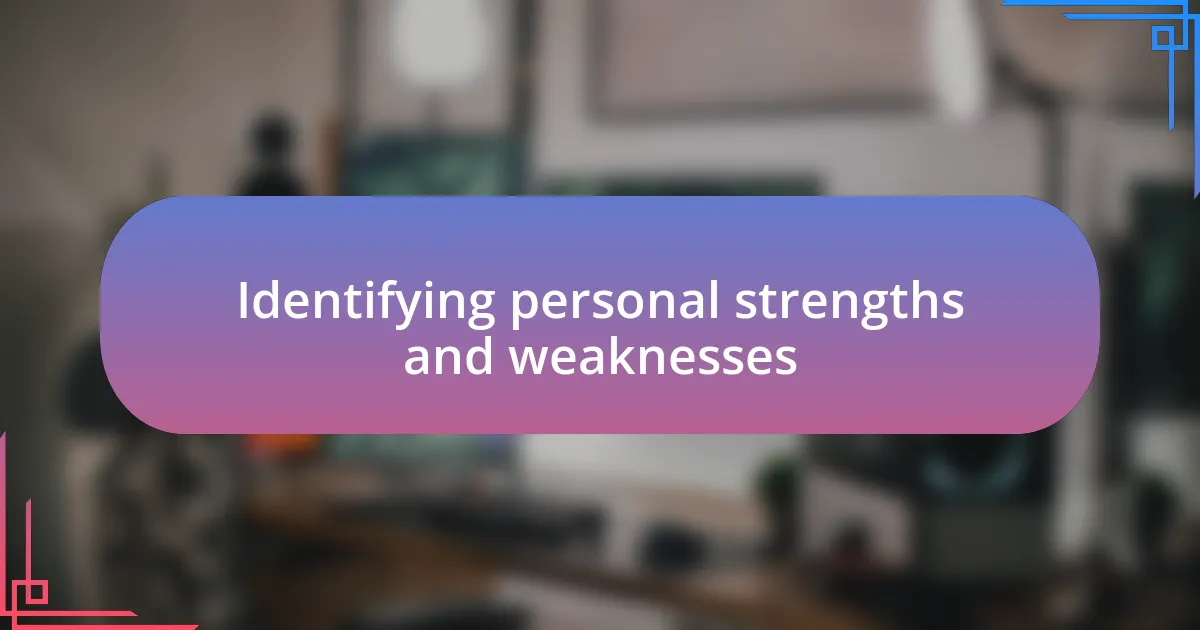
Identifying personal strengths and weaknesses
Identifying personal strengths and weaknesses is a crucial step in adapting to new competitive formats. I’ve discovered that taking a moment for self-reflection helps immensely. One time, after a particularly challenging tournament, I spent a few hours journaling about my performances. I realized I excelled in quick decision-making but often struggled with maintaining my focus under pressure. This understanding transformed my training approach, allowing me to hone in on specific drills that would enhance my concentration during intense moments.
I also learned the importance of seeking external feedback. I remember attending a workshop where peers evaluated each other’s skills. Their insights were eye-opening, as they highlighted strengths I was unaware of and revealed weaknesses I had been ignoring. Embracing constructive criticism was difficult at first, but it empowered me to develop a more balanced skill set and set realistic goals for improvement.
As I reflect on my journey, I’ve come to appreciate that identifying strengths is not just about recognition; it’s about leveraging those qualities in competitive situations. Similarly, recognizing weaknesses isn’t a point of shame but an invitation to grow. This shift in mindset helped me view challenges as opportunities to refine my abilities, ultimately making me a more adaptable and resilient competitor.
| Category | Examples |
|---|---|
| Strengths | Quick decision-making, adaptability, teamwork |
| Weaknesses | Maintaining focus under pressure, time management |
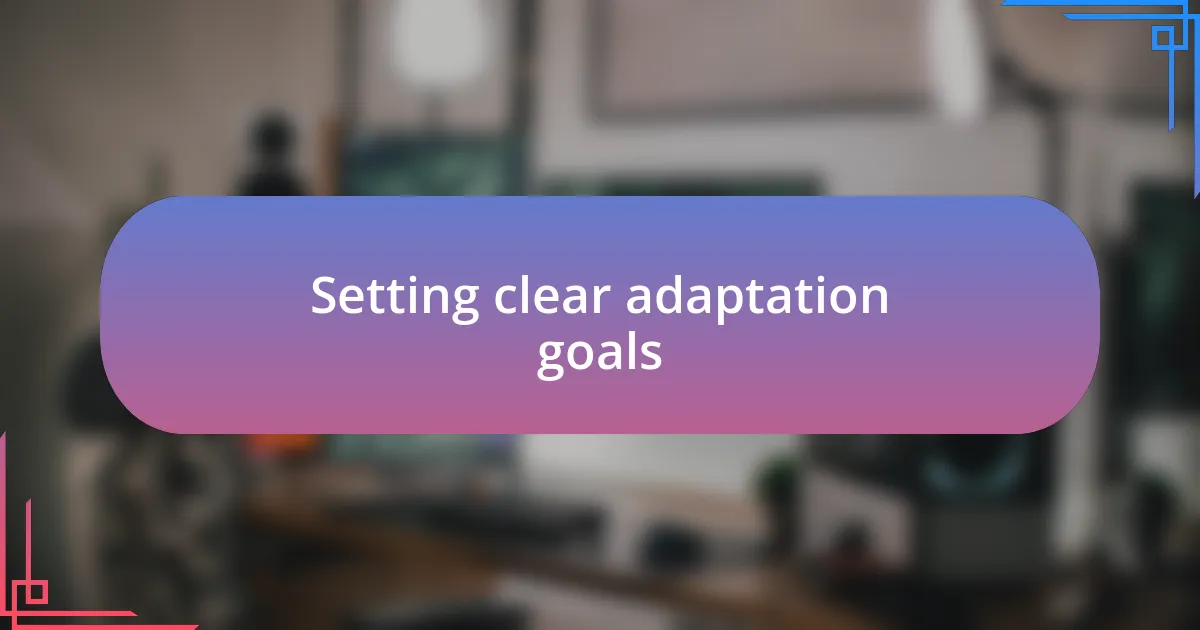
Setting clear adaptation goals
Setting clear adaptation goals is essential for navigating new competitive formats. When I first faced a new challenge, I found myself overwhelmed by the sheer number of skills I wanted to improve. To tackle this, I began by channeling my focus into specific, measurable goals. For instance, rather than just saying, “I want to improve my performance,” I set a clear objective: “I will practice my concentration techniques for 30 minutes every day this week.” This clarity allowed me to track my progress and stay motivated.
I also learned that adaptability requires flexibility in my goals. During one competitive season, I encountered unexpected barriers, such as injuries and shifts in competition styles. These experiences prompted me to adjust my targets frequently. For example, when I couldn’t train as intensely, I shifted my focus to mental preparation. This adaptability in goal-setting helped me stay engaged and made a significant difference in my overall performance.
Reflecting on my experiences, I realized how having well-defined goals created a sense of purpose in my training. It was a game-changer. Have you ever felt lost in your journey to adapt? Setting clear goals not only provides direction but also builds resilience. Remember, it’s not just about the destination; it’s about the process of growth along the way.
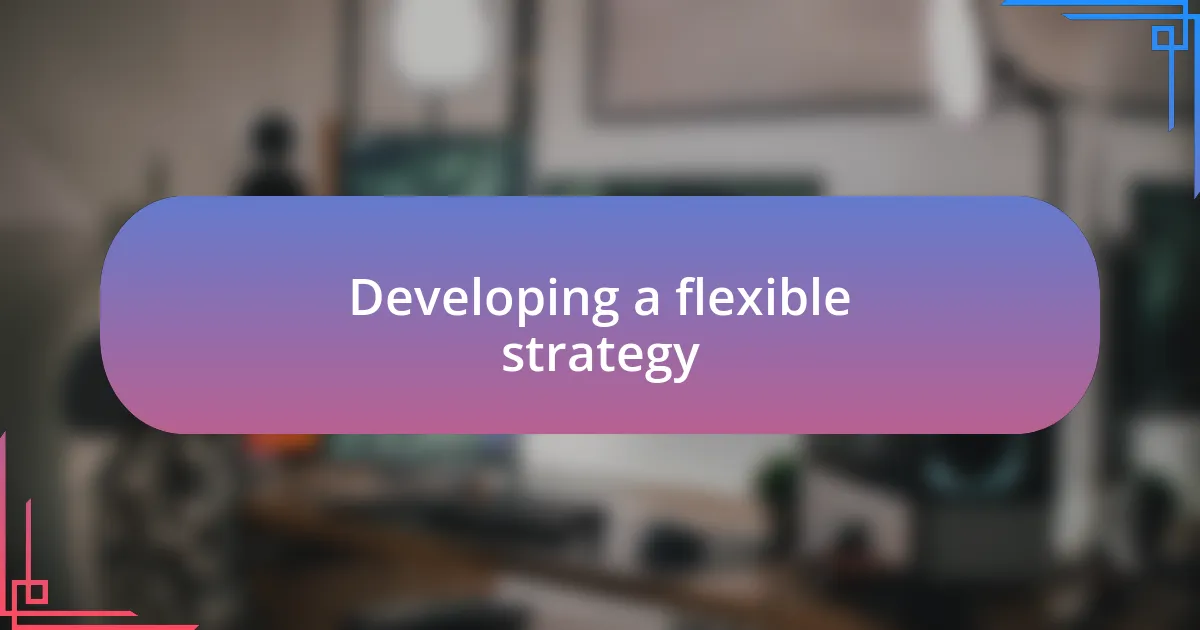
Developing a flexible strategy
Developing a flexible strategy is crucial when facing new competitive formats. I recall a time when I was caught off guard by an unanticipated shift in rules during a tournament. Initially, I felt immense pressure as everything I had trained for seemed to be in jeopardy. However, I quickly realized that flexibility could be my greatest asset. By adapting my game plan on the fly, I managed to find alternative approaches that played to my strengths, which ultimately led to success against the competition.
In my experience, flexibility extends beyond just adapting in the moment; it encompasses a mindset that embraces change. When I decided to diversify my training methods, I found that incorporating various techniques not only kept my routine fresh but also prepared me for any scenario. For instance, when I opted to train with different partners who had unique styles, I began to anticipate challenges I never encountered before. Did I always feel comfortable stepping outside my usual practice? Not at first, but that discomfort taught me resilience and showed me the endless possibilities that come with a flexible approach.
Moreover, I learned that maintaining open communication with my coaches and peers is vital in developing a flexible strategy. When I welcomed feedback and encouraged discussions about our evolving tactics, I not only improved my own performance but also fostered a team environment where adaptability thrived. This mutual support played a crucial role in building our collective resilience. Have you ever felt hesitant to change your approach, fearing it might backfire? Embracing change with the right mindset can turn potential setbacks into opportunities for unexpected growth.
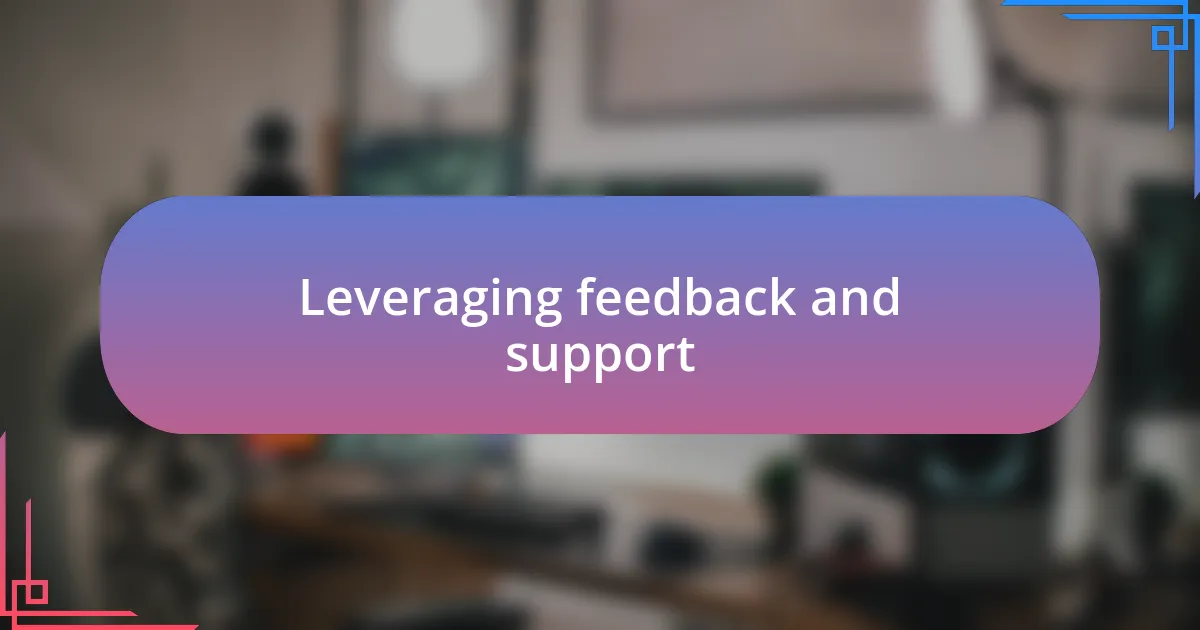
Leveraging feedback and support
Finding the right sources of feedback has been a game-changer in my journey. I still remember the first time my coach suggested I review my performance videos. Watching myself in action was uncomfortable at first; I cringed at mistakes I hadn’t noticed in the heat of competition. But with each review session, I recognized patterns in my play that I could improve. Have you ever had that lightbulb moment when feedback starts to make sense? It’s like gaining a new lens through which to view your performance.
Support from my peers has also been invaluable. During challenging training sessions, my teammates created an environment where we could openly discuss our struggles and victories. I vividly recall a particularly tough week where I felt overwhelmed by the competition’s intensity. One of my friends shared her own experiences with self-doubt, and those shared moments helped me understand that I wasn’t alone in facing obstacles. Did you know that camaraderie can transform individual burdens into collective strength? Knowing that my teammates were rooting for me fueled my determination.
Lastly, I’ve found that seeking feedback isn’t just about improving techniques; it’s about building emotional resilience. After a tough match, I often felt drained, both physically and mentally. However, discussing those feelings with my support network allowed me to process my emotions constructively. It’s interesting how talking about our experiences can reduce stress and make challenges feel less daunting. Have you ever talked through a tough experience and felt a weight lift off your shoulders? The power of support and feedback has been a fundamental part of adapting to new competitive formats for me, reinforcing the idea that growth is a collaborative process.
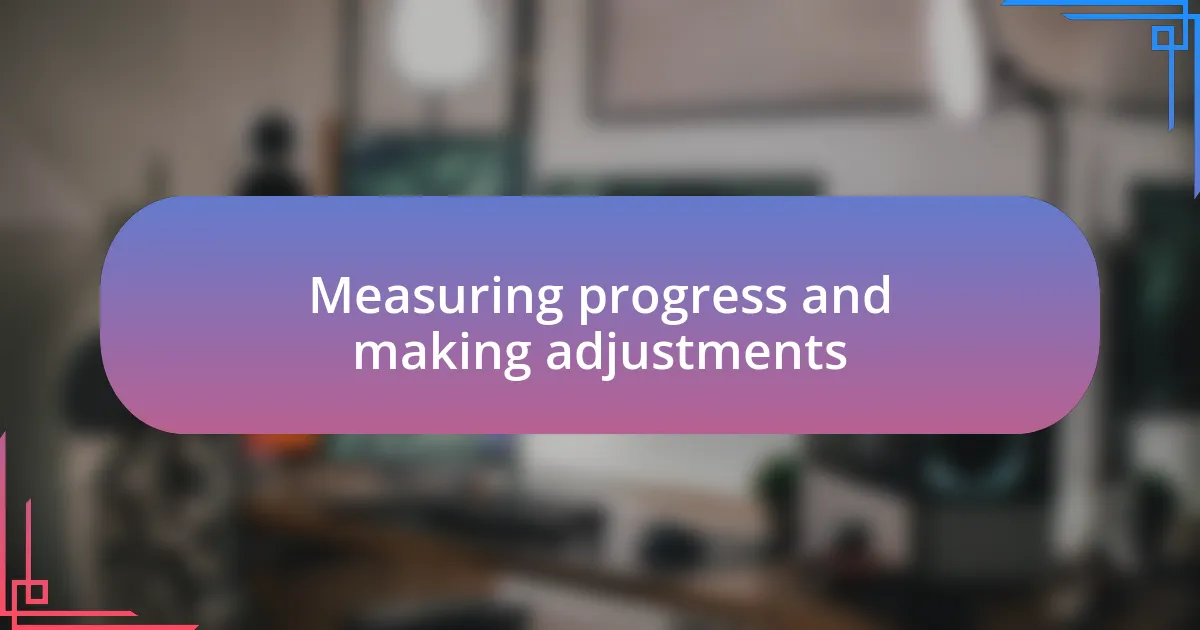
Measuring progress and making adjustments
Understanding how to measure progress is crucial. During my transition to new competitive formats, I began maintaining a performance journal. Each entry detailed my goals, outcomes, and areas for improvement. I still remember the sense of accomplishment when I reflected on my earlier entries and saw how far I had come. Have you ever looked back at your own notes and felt that swell of pride?
Adjustments often stemmed from my progress assessments. After analyzing my performance data, I realized that while my endurance was strong, my strategy needed tweaking. I decided to incorporate specific drills focused on tactical decisions. This wasn’t an easy shift—have you ever struggled with changing something that felt comfortable? Still, the process was rewarding, as I began to see the positive impact of these adjustments in real-time.
Additionally, I learned to embrace the learning curve as a part of measuring progress. Some days, it felt like I was taking two steps backward instead of forward. I vividly remember a tournament where I implemented my new strategies, only to face unexpected challenges. Yet, rather than feeling defeated, I chose to view these setbacks as opportunities for growth. How often do we allow ourselves to view challenges in this light? Ultimately, it’s how we adapt our strategies based on our reflections that leads to continuous improvement.











